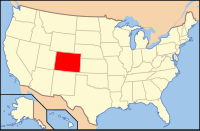San Miguel County, Colorado
| San Miguel County, Colorado | |
|---|---|

The San Miguel County Courthouse
|
|
 Location in the U.S. state of Colorado |
|
 Colorado's location in the U.S. |
|
| Founded | March 2, 1883 |
| Named for | San Miguel River |
| Seat | Telluride |
| Largest town | Telluride |
| Area | |
| • Total | 1,289 sq mi (3,338 km2) |
| • Land | 1,287 sq mi (3,333 km2) |
| • Water | 2.0 sq mi (5 km2), 0.2% |
| Population (est.) | |
| • (2015) | 7,879 |
| • Density | 5.7/sq mi (2/km²) |
| Congressional district | 3rd |
| Time zone | Mountain: UTC-7/-6 |
| Website | www |
San Miguel County is one of the 64 counties of the U.S. state of Colorado. As of the 2010 census, the population was 7,359. The county seat is Telluride. The county is named for the San Miguel River.
San Miguel County was given the Spanish language name for "Saint Michael" due to the nearby San Miguel River. On 27 February 1883, Ouray County was split to form San Miguel County. Originally the San Miguel County portion was to retain the name Ouray County with the new portion called Uncompahgre County.
Mining operators in the San Juan mountain area of Colorado formed the San Juan District Mining Association (SJDMA) in 1903, as a direct result of a Western Federation of Miners proposal to the Telluride Mining Association for the eight-hour day, which had been approved in a referendum by 72 percent of Colorado voters. The new association consolidated the power of thirty-six mining properties in San Miguel, Ouray, and San Juan counties. The SJDMA refused to consider any reduction in hours or increase in wages, helping to provoke a bitter strike.
In 1875, the Smuggler gold vein was discovered near Telluride. The Smuggler-Union, Tomboy, and Liberty Bell mines combined produced over a hundred tons of gold by 1920, third in the state of Colorado.
...
Wikipedia
